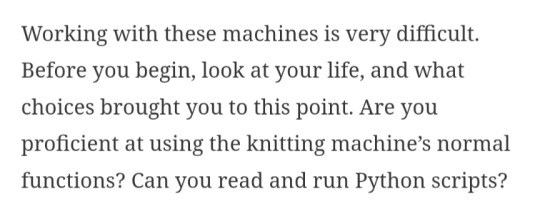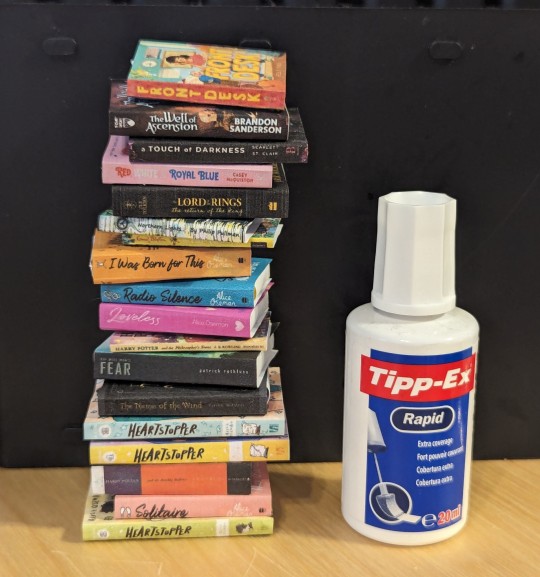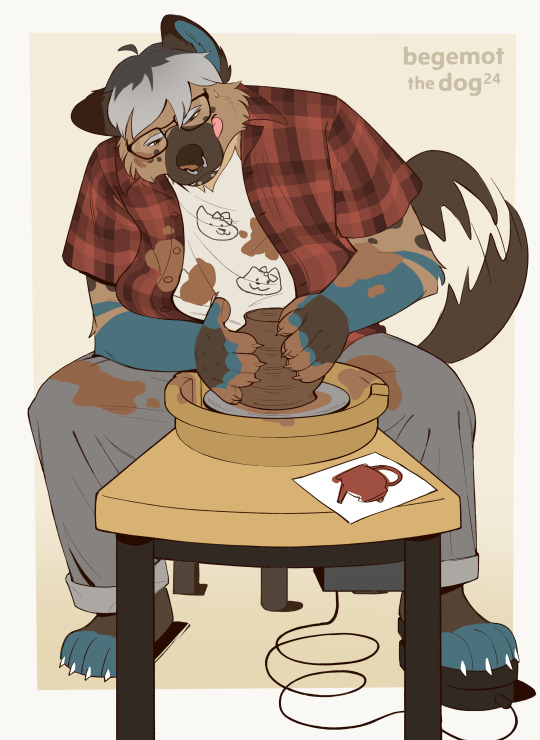# making
Explore tagged Tumblr posts
Text

Found this quote on a website about hacking programmable knitting machines, and I decided you all deserved to witness the poetry of inducing an existential crisis right before reminding us all that this is about a knitting machine.
[ID: A screengrab from a website reading "Working with these machines is very difficult. Before you begin, look at your life, and what choices brought you to this point. Are you proficient at using the knitting machine's normal functions? Can you read and run Python scripts?"]
2K notes
·
View notes
Text

Actually looked at what I was knitting and got wonder struck for a moment of how NICE it looked.
#the stitches are just so beautiful and perfect#k1p1 ribbing#ribbing#red heart#craft#making#craftblr#crafting#crafts#handmade#hand knit#knitblr#knitwear#knitting#rainbow#gradient#ombré
572 notes
·
View notes
Text
Just a little something to celebrate 1k on twitter !!

Nothing better than mashing two of my favourite indies and completely obsessing over them.
If you’re wondering why chara’s there its because of this other little celebratory art i made for 100 twitter followers

And i love tradition 🔥
#slay the princess#undertale#undertale chara#chara#chara undertale#ut chara#stp tlq#the long quiet#stp princess#god i am TRYING so hard to not draw rn#but the demons took over me again#this composition makes no sense thematically#and thats ok#it doesnt have to#i am having fun!!’#god my undertale phase is coming back again#must#resist#making#fanaart#also i can finally use colours#stp is so limiting LMAO#<- silly and unserious ofc theres always a way to incorporate colours in stp fanart
227 notes
·
View notes
Text
Life With Generative Tools
In 2023, back when my posts were still being shared to Twitter because the API wasn’t paid-only, I wrote an article about the potential ramifications of generative art media going forward. My concern in the immediate was that the tools weren’t going to go away, but also the potential harm to artists was as much about general economic precarity and not people using fanart to make their D&D characters. I further added to this with a consideration of how I wanted to avoid using generative art in my game development because I didn’t want what people would say about it. That is, a social pressure about the art is what keeps me from using it, not a personal philosophical disposition. I’m an artist who already works with collage and constraints, this feels like a handy way to have something I can play with.
Well, it’s been a year and change and a sort of AI Art Apocalypse has happened, and if you’re not aware of it, it’s because you’re someone who avoids all of the pools that have been so thoroughly pissed in that they are now just piss. If you’re at all related to any part of the internet where people share a bunch of images – which is to say a lot of social media – then you’re already dealing with the place crawling with generative images. Whether it’s a fanart booru, or big sites like facebook and twitter, or god help you deviantart, there is a pretty clear sign that anywhere that opened the door to generative art became a space overwhelmingly for generative art.
I teach about this subject now and I have had some time with it in a situation away from the internet, and I’d like to give you some insights into what this stuff is for, what it does, why you shouldn’t use it, and ways it can be useful.
Content Warning: I’m going to be talking about these tools as tools that exist and leaving the philosophical/ethical arguments about ‘art theft’ and their genesis aside. I’m not including any examples. No shrimp jesus jumpscare.
You might notice I’m saying ‘generative art’ and not ‘AI art.’ Part of this is because I don’t want to buy into the idea that these tools are ‘artificial intelligence.’ Ironically, ‘AI art’ now has less of an implication of being ‘Artificial Intelligence’ and is much more of an implication of ‘it’s ugly shiny art of shrimp jesus with badly spelled signs.’
I want to focus for this conversation on generative graphical tools, and I want to do that because I don’t have much experience with the other types. The textual generators offer me something I don’t really need? I already make a ton of words of dubious quality. Those are actually the things that concern me because their natural aesthetic is authoritive and comprehensive and that’s why it’s a problem that they’re being used to present any old nonsense that may just be straight up wrong. I don’t use those tools and I avoid the platforms that use them so I’m not familiar with them.
Things Generative Art Is Good For
I already use art I don’t own, a lot, for playing. Every day for the past three years I’ve shared a custom Magic: The Gathering playing card, a game I don’t own the rights to, using a card face I don’t own the rights to, and artwork from an artist on Artstation whose artwork I did not pay for or even ask for. This is generally seen as a totally reasonable and acceptable form of playful, transformative media generation and I at no point pretend I have any rights to the material. If I take a picture of someone famous and put a speech bubble over their mouth saying ‘I drink farts,’ if I, as tumblr says, play with jpgs like dolls, that is by no means being done with rights and permission.
Which means we’re already aware that there’s a way of playing with images that both violates copyright but is generally okay to do.
The metric I use for this is if the thing you’re using generative art for doesn’t matter, then it doesn’t matter. If you’re not going to try and claim money, if you’re not going to put it on a marketplace, if you aren’t going to try and claim ownership and profit off generative material, I think you’re probably fine. I mean probably, if you’re using it to say, generate revenge porn of a classmate that’s an asshole move, but the thing is that’s a bad thing regardless of the tool you’re using. If you’re using it to bulk flood a space, like how Deviantart is full of accounts with tens of thousands of pictures made in a week, then that’s an asshole move because, again, it’s an asshole move regardless of the tool.
If you’re a roleplayer and you want a picture of your Dragonborn dude with glasses and a mohawk? That’s fine, you’re using it to give your imagination a pump, you’re using it to help your friends visualise what matters to you about your stuff. That’s fine! It’s not like you’re not making artistic choices when you do this, cycling through choices and seeing the one that works best for you. That’s not an action deprived of artistic choice!
There are also some things that are being labelled as ‘AI’ which seem to be more like something else to me. Particularly, there are software packages that resize images now, which are often calling it ‘AI upscaling,’ which it may be using some variety of these Midjourney style models to work, but which serves a purpose similar to sequences of resizes and selective blurs. There are also tools that can do things like remove people from the background of images, which is… good? It should be good and easy to get people out of pictures they didn’t consent to be in.
Things Generative Art Is Bad For
Did you know you don’t own copyright on generated art? This is pretty well established. If you generated the image, it’s not yours, because you didn’t make it. It was made by an algorithm, and algorithms aren’t people. This isn’t a complicated issue, this just means that straight up, any art you make at work that’s meant to be used for work, shouldn’t be used because people can just straight up use it. Logo design, branding, all that stuff is just immediately open for bootlegging or worse, impersonation.
Now you might think that’s a bit of a strange thing to bring up but remember, I’m dealing with students a lot. Students who want to position themselves as future prompt engineers or social media managers need to understand full well that whatever they make with these tools are not things that will have an enduring useful application. Maybe you can use it for a meme you post on an account, but it’s not something you can build branding off, because you don’t own it. Everyone owns it.
From that we get a secondary problem, because if you didn’t own it, its only use is what people say or think when they look at it, and thing is, people are already sick and tired of the aesthetics of generated art. You’re going to get people who don’t care glossing over it, and people who do care hating it. Generative art as a way of presenting your business or foregrounding your ‘vibes’ are going to think that your work is, primarily, ‘more AI art’ and not about what it’s trying to communicate. When the internet is already full of Slop, if you use these tools to represent your work, you are going to be turning your own work and media presence into slop.
What’s more, you need to be good at seeing mistakes if you’re using these tools. If you put some art out there that’s got an extra thumb or someone’s not holding a sword right, people will notice. That means you need to start developing the toolset above for fine-tuning and redrawing sections of artwork. Now, that’s not a bad thing! That’s a skill you can develop! But it means that the primary draw of these tools is going to be something that you then have to do your own original work over the top of.
The biggest reason though I recommend students not treat this work like it’s a simple tool for universal application is that it devalues you as a worker. If you’re trying to get hired for a job at a company and you can show them a bunch of generative art you’ve made to convince them that you’re available, all you are really telling them is that you can be replaced by a small script that someone else can make. Your prompts are not unique enough, your use of the tool not refined enough that you can’t just be replaced by anyone else who gets paid less. You are trying to sell yourself as a product to employers, and generative art replaces what you bring with what everyone brings.
They make you lazy! People include typos in the generative media because they’re not even looking at them or caring about what they say! And that brings me to the next point that there are just things these tools don’t do a good job doing, and that’s stuff I want to address next in…
Things That Are Interesting
Because the tools of generative art create a very impressive-seeming artistic output, they are doing it in a way that people want to accept. They want to accept them and that means accepting the problems, or finding a way to be okay with those problems. People who don’t care that much about typos and weird fingers and so on, because you know, it gets me a lot of what I want, but it doesn’t get me everything, and I don’t know how to get the everything.
If you generate an image and want to move something in it a little bit, your best way to do that is to edit the image directly. Telling the software to do that, again, but change this bit, this much, is in fact really hard because it doesn’t know what those parts are. It doesn’t have an idea of where they are, it’s all running on an alien understanding of nightmare horror imagery.
What that means is that people start to negotiate with themselves about what they want, getting to ‘good enough’ and learning how to negotiate with the software. My experiments with these tools led to me making a spreadsheet so I could isolate the terms I use that cause problems, and sometimes those results are very, very funny. In this, the tool teaches you how to use it (which most tools do), but the teaching results in a use that is wildly inappropriate to what the tool promises it’s for.
One of my earliest experiments was to take four passages from One Stone that described a character and just put that text straight into midjourney to see what it generated based on that plain text description. Turns out? Nothing like what I wanted. But when I treated it like say, I was searching for a set of tags on a booru system like danbooru or safebooru… then it was pretty good at that. Which is what brings me to the next stage of things, which is like…
These things were trained on porn sites right?
Like, you can take some very specific tags from some of the larger boorus and type them into these prompt sites and get a very reasonable representation of what it is you asked for, even if that term is a part of an idiolect, a term that’s specific to that one person in one space that’s become a repeated form of tag. Just type in an artist name and see if it can replicate their style and then check to see what kind of art that artist makes a lot of. This is why you can get a thing that can give you police batons and mirrored sunglasses just fine but if you ask for ‘police uniform’ you get some truly Tom of Finland kind of bulging stuff.
Conclusion
Nobody who dislikes generative art is wrong. I think there are definitely uses of it that are flat out bad, and I think it’s totally okay and even good to say so. Make fun of people who are using it, mock the shrimp jesuses, make it very clear you’re aware of what’s going on and why. There’s nothing wrong with that.
I do think that these tools are useful as toys, and I think that examining the art that they produce, and the art that the community around them are exalting and venerating tells us stuff. Of course, what they tell us is that there are a lot of people out there who really want porn, and there are just as many people who want the legitimisation of impressive seeming images that they don’t care about what those images are doing or what they’re for.
Now part of this defensiveness is also the risk of me being bitten. If I buy stock art that isn’t correctly disclosed as being generative art, then I might make and sell something using generative art and now I look like an asshole for not being properly good at detecting and hating ‘AI art,’ and when I’ve say, made a game using generative art that then is integrated into things like worldbuilding and the card faces, then it gets a lot harder to tear it out at the roots and render myself properly morally clean. I’m sure a bunch of the stock art I used before 2020 was made algorithmically, just pumped out slop that was reprocessing other formula or technical objects to fill up a free stock art site like Freepik.
Which is full of generative art now.
You won’t hurt yourself by understanding these things, and people who are using them for fun or to learn or explore are by no means doing something morally ill. There are every good reason to keep these things separated from anything that involves presenting yourself seriously, or using them to make money, though. If nothing else, people will look at you and go ‘oh, you’re one of those shrimp jesus assholes.’
Check it out on PRESS.exe to see it with images and links!
158 notes
·
View notes
Text



I made some tiny books 📚
#book#osemanverse#alice oseman#art#books and reading#heartstopper#nick and charlie#solitaire alice oseman#front desk#a touch of darkness#red white and royal blue#lord of the rings#northern lights#the far away tree#the name of the wind#the wise mans fear#patrick rothfuss#harry potter#tiny things#i made this#tiny books#small books#book tumblr#crafts#radio silence#i was born for this#loveless#making
428 notes
·
View notes
Text
He's trying hard just to let us get some good tea from a cute teapot!!😭🤍

Commission for arelhyhahaha on Twitter!🍵
#digital#art#furry#artwork#drawing#furry art#anthro#furry anthro#sfw#hyena#pottery wheel#tea#teapot#making#effort#mess
356 notes
·
View notes
Text









૮ 。ˊᯅˋ ა
#this#is literally#making#my pc#lag#SO BAD#jing yuan#hsr jing yuan#hoyofair#honkai#hoyoverse#hsr#hoyocreators#hoyo games#hoyolab#hsr icons#honkai star rail#hsr gifs#gifs#gifset#messy gifs#stim gifs#animated gifs#gif warning#glitter#light pink#sparkly#pastel#hot pink#pink
81 notes
·
View notes
Text




Photos by Greig Fraser
#Greig Fraser#Timothée Chalamet#Zendeya#Jason Momoa#dune part one#dune#cinematographer#making#behind the scenes
116 notes
·
View notes
Text

When I do cross-stitch I wax my thread, which makes it easier to get onto the needle and in my opinion causes fewer tangles. I use plain beeswax, and I've had the same puck (bought from Yankee Candle) for years because you don't need much wax for thread. But the puck was finally getting a little fragile and I wanted to have separate pucks for separate projects anyway. So I busted out my wax sealing kit and melted the puck into three separate round molds, then when they were cool I sealed the top of each with a different stamp.
The sealing wax is the new "supple" wax which is mostly vinyl polymer (think hot glue, but nicer) so it can't be used to wax the thread, but it's a good reinforcement for the beeswax, which tends to get deep grooves and then crumble. And I think they look quite nice, too.
230 notes
·
View notes
Text
The encounter between Marius and Courfelac
Comparison of rough sketch and line drawing
57 notes
·
View notes
Text

#september carrino#venus#hugebreasts#neked body#sunshine#poolside#nipple that make you want to suck#big areola#exposed huge breasts#making#neked
71 notes
·
View notes
Text

Paper making in northern Vietnam
French vintage postcard
#postkaart#Vietnam#ephemera#postal#tarjeta#postcard#postkarte#vintage#carte postale#briefkaart#sepia#ansichtskarte#making#photo#French#photography#historic#Paper#northern
16 notes
·
View notes
Text
Dragon Regulation
Dragons are cool
I don’t think that’s a controversial opinion. I think that, broadly speaking, if I put a thing in a fantasy universe and put it within certain benchmarks for what constitutes dragon-y-ness, it’ll be accepted as a dragon. And maybe you’re much more loose and casual about it, but I think about how there are rules for dragons. Or if there aren’t any, shouldn’t there be?
Rules For Being A dragon
Dragons are like pornography. I can’t define it for you but I sure know it when I see it and also terabytes of them have passed through my screens each year. But more the first part.
You can call anything you want a dragon. In the real world, we call a type of fruit a dragon, and a bug, and a very cute lizard, a bigger less cute but still cooll lizard, and a seahorse and a slug and a millipede that makes zyklon-B.
Yeah, really.
Messed up, huh?
Anyway, the point is, dragon isn’t a special title. You don’t actually have to fulfill any obligations to be considered a dragon. It isn’t about being a lizard or about being able to fly or being able to breathe fire or even something like number of legs. This extends into your world and what you mean when you say a dragon dragon.
Here’s a list of just… stuff that I’ve seen about dragons in different sources.
They’re ancient reptilian flame-breathing hexapodal creatures with two wings and four legs but no hands, like Smaug from The Hobbit Part 3.
They’re long ferret-like creatures that fly without wings, and a serpentine body, fluffy hair and antlers, like in Raya and the Last Dragon.
They’re round, with tiny flappy wings and big yellow eyes, like How to Train Your Dragon‘s Gronckle.
They’re a sinuous dinosaur-bird with a huge jagged beak and crest, like Ridley from Metroid.
These are just a handful of things, but while all of these things can be called dragons, none of them seem to ‘break’ the term, right? But what about:
Chrono Cross has a dragon that’s a human-shaped clown.
Seath the Scaleless from Dark Souls has no scales, which isn’t actually that big a deal compared to how he has no legs.
Like A Dragon is a game about Yakuza dudes.
temtem has a feathered serpent with no limbs as a dragon.
Pokemon has Exeggutor, which is a walking palm tree with four heads.
Bubble Bobble has two dragon protagonists who have no wings and barely necks.
Mario has Bowser? Who may? be a dragon? But he’s also a turtle, and lacks wings?
There are even more examples of things that are ‘dragons,’ and that seem to sit outside a single, obvious specific intersection of ‘dragon-ness.’ In your worldbuilding then, the thing to consider is what you need ‘dragon’ to do or mean. In Like A Dragon, the term Dragon is used as a reference to literature: nobody in that game is actually producing a real dragon because in that story, dragons aren’t real, except as a thing people can be, and – you know, so on.
To that end: Work out what Dragon is supposed to mean. It isn’t necessary to have rules, but it helps if you know whether or not you need them. For myself, I like the idea of dragons as very magical but materially real creatures. I like the idea that they fly with their wings, that they are very muscular, that they have a lot of weight, and that while there are a lot of virtues to being what they are, biologically speaking, they are creatures that exist, and follow rules. They’re long-lived, they eat, they drink, and they sleep.
Rules for Treating A Dragon
Okay so you have some rules, or some guidelines at least, in your mind for what a dragon is, what makes a thing a dragon. In my case, I started with ‘it’s big, magical, and it’s a meaty, material entity, not a god, or somehow fundamentally supernatural.’ The way I tend to think of a dragon is as a single character that represents a government you have to negotiate with or deal with.
How does the world treat dragons?
In your world, are dragons mysterious? Are they history or are they nonsense? Do people have the idea of dragons but no experience with what they really are? Are dragons common, such as things like kobolds (are they dragons, to you?) or Dragonborn? What about half-dragons? Kinda hard to claim that dragons are fake if you’ve got a queen who’s been famously a half-dragon for generations, at least, if that’s a claim that’s somehow believable.
Dragons are pretty materially significant: are there laws about dragons?
Consider, if a dragon is a dangerous thing that can endanger a city, it might be illegal to contact dragons. It might be seen as just fundamentally a dangerous thing for a random citizen to do because talking to a dragon could get the dragon’s attention on the city. In the real world, there are laws against doing things that can cause landslides, there are laws against encouraging wild animals to approach the city, and there are laws about contacting dangerous political entities.
A dragon is kinda like all three?
Rules For Slaying A Dragon
Who can fight dragons in your story?
Not everyone, right?
A dragon is something that in your mind is probably only going to show up if it’s important and difficult. It’s a term with a degree of prestige. You don’t just beat up a dragon in an alleyway, and you don’t go out slaying dragons like they’re rats. I mean, you might if you think of kobolds as a type of dragon, and maybe a setting where there are populations of feral dragons providing problems in city infrastructure could be interesting to go in one way or another, but by default, nah.
Dragons are dangerous.
Who kills a dragon? I’ve written about this in the past, in my talk about the way that a dragon is a surrogate government. Thing is, you gotta consider in your stories and your worlds what stops a dragon, what displaces or defeats a dragon. Can they be? Can they be reasoned with? I compare them to states, but are dragons going to have the needs of states, can they be reasoned with? Do they have the economic presence of a state?
Most of the time when you see a dragon defeated, it’s a story about someone who should defeat the dragon doing it. It’s very rarely a peasant uprising, it’s usually a knight or a prince and it very commonly is connected to a justifiable cause to go deal with the dragon. It’s really interesting to because it feels like to an extent, a dragon, at least an evil or hostile one, is a bit like a rogue state? And wouldn’t there be a clear idea that ‘hey, someone should go deal with this, or what it’s doing?’
Forgetting About Drakes
None of this is necessary, of course. Dragons are such iconic creatures that you can just have one apepar in a story in the world and people will go ‘oh, yeah, dragons, we know what those are.’ You don’t have to consider them as economic engines or state actors that result in regulation.
But isn’t it more interesting when you do?
Check it out on PRESS.exe to see it with images and links!
93 notes
·
View notes